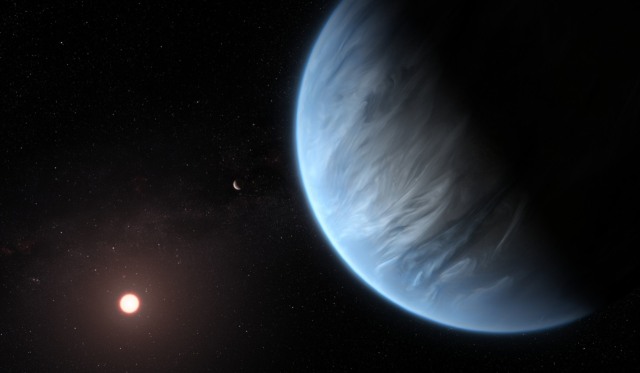Scientists identify new class of planet with massive oceans possibly home to alien life!

Scientists are like, we need to get the fuck outta here. We gotta find some habitable fucking planets. Well, they’ve found some massive ass ocean worlds. Good job, dorks. Good job, eggheads. Just kidding, I fucking love ya’ll. Now these planets. Do they have life? Perhaps! Could they support our life? Not sure! None the less, meet these fucking “Hycean” planets!
Vice:
Earth is the only planet known to host life, which is why the search for alien beings has largely focused on worlds that appear similar to our own. But now, scientists have offered up a compelling new glimpse of extraterrestrial habitability: large ocean worlds with hydrogen-rich atmospheres called “Hycean” planets (a portmanteau of hydrogen and ocean).
A team led by Nikku Madhusudhan, an astrophysicist and exoplanetary scientist at the University of Cambridge, proposed that these relatively overlooked planets “can be optimal candidates in the search for exoplanetary habitability and may be abundant in the exoplanet population,” according to a study published on Wednesday in The Astrophysical Journal.
What’s more, Hycean planets are much easier to observe and characterize compared to Earth-like rocky worlds, which means they could be scanned for signs of life by next-generation observatories, such as the James Webb Space Telescope, within the next few years.
“Up until now, whenever you hear about habitable planets, you’re basically picturing an Earth 2.0,” Madhusudhan said in a call. “You’re picturing an Earth-like planet with an Earth-like atmosphere and surface and you put it around the star at the right temperature so you can have liquid water. That has been our canonical notion of habitability.”
Hycean planets, in contrast, are about two to three times bigger and up to 10 times more massive than Earth, placing them within other exoplanetary categories such as “super-Earths” and “mini-Neptunes.”
Though our own solar system lacks any planets in this size range, they are extremely common in other star systems, which has led to cautious speculation about whether they might be able to host life. These worlds could have extensive oceans of liquid water, which is a plus for habitability, but their huge masses may create pressures that are simply too high to support life. Their thick hydrogen atmospheres can also reach sweltering temperatures of 200°C, suggesting that many of these worlds are too hot to be habitable.
Madhusudhan got thinking about the odds of alien life in these extreme environments after studying exoplanet K2-18b, which is located about 124 light years away and orbits within the habitable zone of its star, meaning that liquid water could exist on its surface.
Sure enough, scientists announced in 2019 that they had detected water vapor in K2-18b’s atmosphere, making it the first habitable-zone exoplanet with confirmed signs of the most important ingredient for life as we know it. However, K2-18b is about eight times as massive as Earth, a heft that may place too much pressure on its environment for any lifeforms to emerge.
Madhusudhan and his colleagues explored the properties of K2-18b in a recent study and were surprised to find “a range of solutions allowing for habitable conditions” at the surface of this world, which is labelled a “candidate Hycean planet” in the new study.
“The size of the planet is around two and a half times that of Earth, so no one in their wildest dreams would call that habitable if you’d had that big a radius in the past,” Madhusudhan said. “Even I didn’t know that it would be habitable.”
“That was the ‘aha’ moment,” he added. “And it got me thinking: Well, what else is out there?”
To build on those findings, the new study expands its scope to include many other nearby Hycean candidate planets that might be hospitable to life, including TOI-732 c, LTT 1445 A b, and K2-3 c. The team also established that the habitable zone for Hycean planets could be exponentially bigger than for Earth-like planets, because of the vast range of different environments that these planets might offer.
For instance, “Dark Hycean” planets might have such tight orbits that they become tidally locked, meaning that one planetary face is always pointed toward the star. In those cases, life might emerge only on the cooler nighttime sides of these two-faced worlds. At the other extreme, “Cold Hycean” planets might orbit at a huge distance from their star, or they could even be rogue planets that are not bound to any star system at all. Heat generated by the hydrogen-rich atmosphere of these farflung planets could potentially support some form of sunless life, according to the study.
“If you look at the extremes in pressure and temperature in which life can survive in Earth’s oceans, those are the conditions we are imposing here,” Madhusudhan said. “Temperatures around 140°C, or 395 Kelvin, and 1,000 bars of pressure, are the limit in which extreme life can survive on Earth. As long as the surface temperatures and pressures are below that, we’re saying you could have that kind of life.”
It’s hard to speculate about exactly what hypothetical Hycean aliens might look like, given the otherworldly nature of these planets. But we may not have to wait too long to get some idea of whether these worlds are habitable, because their huge sizes and thick atmospheres make them easy targets for telescopes designed to spot signs of life, or biosignatures.
“At this point, we have done the initial theory and created a category, which is in itself a paradigm shift in our understanding,” Madhusudhan said. “Now let’s be open to these worlds and just go look.”
“Even if we find that there is no life, that is a really good constraint on the possible origins and rarity of life,” he concluded. “There’s a lot of fundamental science that can come out of these observations anyway, so we should just go look.”



